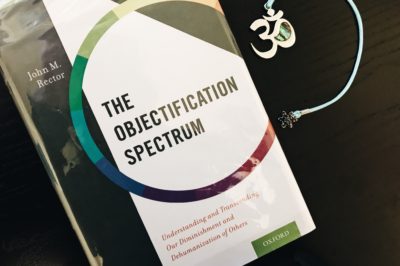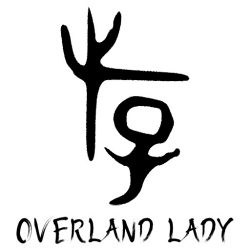The Objectification Spectrum
- Understanding and Transcending Out Diminishment and Dehumanization of Others.

This is a scholar book I borrowed from school library – I’d assume it is for psychology or philosophy students’ research purpose. It has been renewed multiple times because I have been really short in time to read but also too selfish to let it go.
I’ve thought about buying one copy to keep.. But after searching on Amazon, I decided to take down some notes from my reading and leave the purchase to future need. I truly believe the knowledge from this book is worth more than twice of the other books out there. But I might just put that $50 somewhere else than possibly turning it to another dust-collector on my bookshelf.
Objectification
In a broad sense, “Objectification” refers to “treating a person as an object”. There are different levels within the range from casual indifference, to derivatization and/or emotional hardening, to dehumanization, along which the potential for violence increases.
In Sex and Social Justice, Nussbaum listed 7 dimensions of objectification:
- Instrumentality. Treating the other person as a tool of his or her purposes.
- Denial of autonomy. Treating treats the other person as lacking in autonomy and self-determination.
- Inertness. Treating the other personas lacking in agency, and perhaps also in activity.
- Fungibility. Treating the other person as interchangeable (a) with other objects of the same type and/or (b) with objects of other types.
- Violability. Treating the other person as lacking in boundary integrity, as something that it is permissible to break up, smash, break into.
- Ownership. Treating the other person as something that is owned by another, can be bought or sold, etc.
- Denial of subjectivity. Treating the other person as someone whose experience and feelings (if any) need not be taken into account.
Later, Rae Langton expanded 3 additional features in the Social Solipsism :
- Reduction to body: Treating the other person as identified with their body, or body parts;
- Reduction to appearance: Treating the other person primarily in terms of how they look, or how they appear to the senses;
- Silencing: Treating the other person as if they are silent, lacking the capacity to speak.
The fundamental problem is perceiving oneself as separate and distinct from the rest. In the West, it is referred to “the problem of the ego”, “i am not that”.
Derivatization
Derivatization refers to portraying other people primarily as one’s desires, wishes, fears etc. Other elements of the person are disregarded, ignored, or under-valued.
For example, portraying female as purely sexual parts or sexual functions which the male desire. She is reduced to the mere sexual instrument while her other traits are treated as non-existence. Such sexual objectification / derivatization often happen to people like prostitutes and Playboy bunnies.
Dehumanization
The extreme level of objectification is seeing someone as not fully human (lack of “human essence”), or less than human. The perception to other as subhuman can often lead to treating him/her in a brutal, degrading way.
Note, don’t misunderstand Dehumanization with Cognitive Dissonance where bad behavior comes first, then the person adopt a new attitude afterwards to feel mentally at ease. For dehumanizer, the attitude comes first, behavior follows.
Over the ages, distinctions between “us” and “them” has been constantly reinforced by propaganda. Especially during wars. Killing and torturing other human being is a hard thing to do. Seeing them as “not humans”, or even some “wicked beings” ease off the scruples. It reduces the negative emotion which otherwise will arise from harming others.
The factors contributing to this uniquely human phenomenon include narcissism, the ego, death denial, toxic situations, and our perceived boundaries of self.
Language
The Buddha identified 5 states of being: Appearance, Name, Discrimination, Right Knowledge, and Suchness.
Given the things that we can touch, see, hear, and smell from Appearances state, we start to Name them. From the Buddha’s perspective, language acts as a distancer and contribute to the separation that human feel from each other and the world around. The labeling foreshorten and minimize the existence of the individual. By labeling or naming her “woman”, it is as if she can suddenly be understood totally, while the unfathomable depth this person possess is covered up. When depth is lost, perceived separation increases and the objectification becomes more likely.
Our ability to think comparatively leads to the tendencies to stack ourselves up against perceived ideas, and find inadequacies in ourselves.
Boundaries
Human perception is composed of pairs of opposites. For example, tall vs. short, ripe vs. unripe bananas. They do not exist in nature. It brings all kinds of varieties. “Nature never apologizes” because it doesn’t express any value or principle, but human beings do.
![]()
Here’s a more visual representation: ou may be seeing a “star” on the left. In fact, it is simply a boundary on a blank space which did not exist until I post this article. It used to be a unified white space, now the boundary creates “space inside the star” which is now differentiated from the “space outside the star”. In short, drawing boundaries manufactures opposites.
Boundary creates opposite pairs, which then lead to tension and conflict.
The definition of self come from self-boundary. It is the line a person draws between him/her and anything else. The inside is “me”, outside is “not me”.
Objectification arises from a misappropriation of boundaries that place limits on ourselves and exclude the “other” from our consideration of what really matters.
The Skin Barrier
“me” – beneath the skin.
“not me” – outside the skin.
“mine” – possessed, but not “me” in the same way as underneath skin.
level 1. The Persona
In this level, the person’s sense of self is not necessarily synonymous with their body or the skin. They may feel that they have a body, not that they are a body. Their sense of self seem to be located in a certain region of the brain or mind.
People in this stage of self-recognition may be prone to self-harm. The central cause of self-injury is a high degree of alienation from her own body and emotions. Her body and certain thoughts and feeling were not part of the “‘self-system’, but a bad, foreign entity, unworthy of compassion or consideration.”
level 2. The Ego
At this stage, the person can identify with her thoughts. She is able to think rationally about life’s many adversities and keep emotions manageable.
Despite the wisdom, the boundary remain at a level of consciousness. The body and and the rest of the organism is not included – “I am my head, but not my body”.
level 3. Centauric Awareness
Finally, at this level, “me” is a unity of the body and mind.
Centauric Awareness is a “meaningful present awareness”. It focus on the present moment which is perceived as always passing away into the past while expecting a future which always has yet to be.
level 4. The Transpersonal
The sense of self is determined by where we are focusing our conscious awareness. People at this level often experience all objects from the environment as if they were part of their own selves. It opens the possibility to confirm that the world really is one’s own self. It becomes clear “how the world’s great saints and mystics, such as the Buddha, Jesus, or Mahatma Gandhi, were able to garner such radical compassion and identification with all existence.”
Narcissism
Narcissism is a built-in emotional distancer which put all human into objects.
The Ego
It is possible for people to develop a more distant, detached acknowledgement of his or her thoughts and feeling. This “diffused” perspective means being the awareness behind the thought or feeling, rather than being the thought or feeling.
No amount of having ever satisfy Ego. Wanting is part of its structure.
